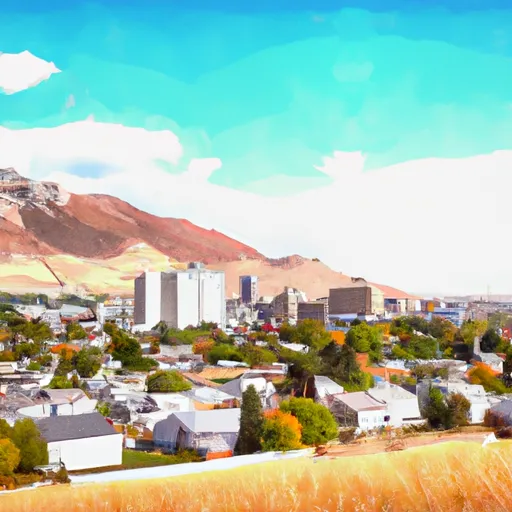-
 Snoflo Premium
Snoflo Premium
Get unlimited access to all our content
With no Ad interruptions! - Start Your Free Trial Login with existing account
Richmond
Eden Index
Climate
8.3
•
Recreation
7.3
•
Community
1.7
•
Safeguard
6.3/10

Richmond, Utah is a small town located in Cache County. It experiences a semi-arid climate with hot and dry summers and cold winters. Summers are generally sunny with temperatures reaching the high 80s°F, while winters are cold with temperatures dropping below freezing and occasional snowfall.
The town is situated near the Bear River, making hydrology a prominent feature. The river serves as a vital water source for the area and supports diverse aquatic life, including trout and various bird species. Additionally, the Bear River provides recreational activities such as fishing and boating.
Richmond offers a range of outdoor recreation opportunities due to its proximity to the surrounding mountains and natural landscapes. The nearby mountains provide opportunities for hiking, camping, and wildlife observation. Furthermore, the surrounding area offers fantastic hunting spots for enthusiasts.
The Minnetonka Cave, located just a short drive away, is a popular tourist attraction offering guided tours through a network of stunning limestone formations. In addition, the nearby Hardware Ranch Wildlife Management Area provides a unique opportunity to witness hundreds of elk during the winter months.
Overall, Richmond, Utah offers a diverse climate, a rich hydrology system, and numerous outdoor recreational opportunities, making it a desirable destination for nature enthusiasts.
What is the Eden Index?
The Snoflo Eden Index serves as a comprehensive rating system for regions, evaluating their desirability through a holistic assessment of climate health, outdoor recreation opportunities, and natural disaster risk, acknowledging the profound impact of these factors on livability and well-being.
Climate Health Indicator (CHI): 8.3
Richmond receives approximately
502mm of rain per year,
with humidity levels near 68%
and air temperatures averaging around
9°C.
Richmond has a plant hardyness factor of
5, meaning
plants and agriculture in this region thrive during a short period during spring and early summer. Most
plants will die off during the colder winter months.
By considering the ideal temperature range, reliable water supplies, clean air, and stable seasonal rain or snowpacks, the Climate Health Indicator (CHI) underscores the significance of a healthy climate as the foundation for quality living.
A healthy climate is paramount for ensuring a high quality of life and livability in a region, fostering both physical well-being and environmental harmony. This can be characterized by ideal temperatures, reliable access to water supplies, clean air, and consistent seasonal rain or snowpacks.
Weather Forecast
Streamflow Conditions
Lower Bear
Area Rivers
Lower Bear
Snowpack Depths
Lower Bear
Reservoir Storage Capacity
Lower Bear
Groundwater Levels
Recreational Opportunity Index (ROI): 7.3
The Recreational Opportunity Index (ROI) recognizes the value of outdoor recreational options, such as parks, hiking trails, camping sites, and fishing spots, while acknowledging that climate plays a pivotal role in ensuring the comfort and consistency of these experiences.
Access to outdoor recreational opportunities, encompassing activities such as parks, hiking, camping, and fishing, is crucial for overall well-being, and the climate plays a pivotal role in enabling and enhancing these experiences, ensuring that individuals can engage in nature-based activities comfortably and consistently.
Camping Areas
| Campground | Campsites | Reservations | Toilets | Showers | Elevation |
|---|---|---|---|---|---|
| High Creek | 2 | 5,521 ft | |||
| Albert Moser | 9 | 5,281 ft | |||
| Tony Grove Lake | 41 | 8,111 ft | |||
| Heart Mountain Spring | 4 | 5,225 ft | |||
| Smithfield | 6 | 5,566 ft | |||
| Redpoint | 10 | 4,889 ft | |||
| Willow Flat | 55 | 6,108 ft | |||
| Maple Grove | 12 | 4,907 ft |
Nearby Fishing
Nearby Ski Areas
Catastrophe Safeguard Index (CSI):
The Catastrophe Safeguard Index (CSI) recognizes that natural disaster risk, encompassing floods, fires, hurricanes, and tornadoes, can drastically affect safety and the overall appeal of an area.
The level of natural disaster risk in a region significantly affects safety and the overall livability, with climate change amplifying these risks by potentially increasing the frequency and intensity of events like floods, fires, hurricanes, and tornadoes, thereby posing substantial challenges to community resilience and well-being.
Community Resilience Indicator (CRI): 1.7
The Community Resilience Indicator (CRI) recognizes that education, healthcare, and socioeconomics are crucial to the well-being of a region. The CRI acknowledges the profound impact of these elements on residents' overall quality of life. By evaluating educational resources, healthcare accessibility, and economic inclusivity, the index captures the essential aspects that contribute to a thriving community, fostering resident satisfaction, equity, and social cohesion.

